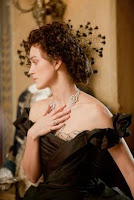 "Anna
was not in lilac, as Kitty had so urgently wished, but in a black, low-cut,
velvet gown, showing her full throat and shoulders, that looked as though
carved in old ivory, and her rounded arms, with tiny, slender wrists. The whole
gown was trimmed with Venetian guipure. On her head, among her black hair - her
own, with no false additions - was a little wreath of pansies, and a bouquet of
the same in the black ribbon of her sash among white lace. Her coiffure was not
striking. All that was noticeable was the little wilful tendrils of her curly
hair that would always break free about her neck and temples." ― Leo
Tolstoy, Anna Karenina (1877)
"Anna
was not in lilac, as Kitty had so urgently wished, but in a black, low-cut,
velvet gown, showing her full throat and shoulders, that looked as though
carved in old ivory, and her rounded arms, with tiny, slender wrists. The whole
gown was trimmed with Venetian guipure. On her head, among her black hair - her
own, with no false additions - was a little wreath of pansies, and a bouquet of
the same in the black ribbon of her sash among white lace. Her coiffure was not
striking. All that was noticeable was the little wilful tendrils of her curly
hair that would always break free about her neck and temples." ― Leo
Tolstoy, Anna Karenina (1877)
I’m
not sure why I chose this quote for today, except that the image it creates in
the mind is unforgettable—and that it offers ample evidence of the considerable
storytelling power of Leo Tolstoy, as well as a hint of the title character’s
passion, charm and noncomformity that will lead to her illicit affair and growing
isolation from Russian society.
Not
for Anna the pastel-like tones that other women (including Kitty) are wearing
at the ball. Black, so simple,
nevertheless makes her stand out. She has taken no extra pains on her
appearance; her natural beauty is enough to guarantee she’ll draw stares. The
only unusual word about this passage is “willful”—suggesting her
eventual defiance of norms, along with the phrase that quickly confirms this hint: “break
free.”
Anna Karenina is
a novel whose enormous size makes it appear intimidating. But it is one of the
most memorable books I have ever read, and even short passages like the one
above are so rich in color and meaning that it illustrates why.
(The
image accompanying this post comes from the 2012 version of the novel. Keira
Knightley, shown here, is just one of a number of actresses who have played
this unforgettable heroine on the big and small screen, including Greta Garbo,
Vivien Leigh, Jacqueline Bisset, Nicola Pagett, Sophie Marceau, and Helen
McCrory.)
No comments:
Post a Comment